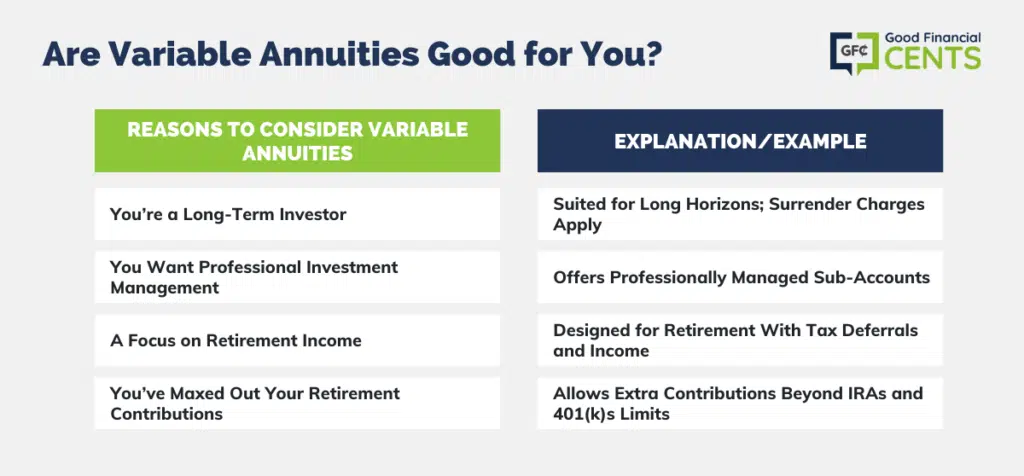All Categories
Featured
Table of Contents
Just as with a repaired annuity, the owner of a variable annuity pays an insurer a lump amount or series of settlements for the pledge of a series of future payments in return. As pointed out above, while a fixed annuity expands at a guaranteed, continuous price, a variable annuity expands at a variable rate that depends upon the efficiency of the underlying financial investments, called sub-accounts.

During the buildup stage, assets invested in variable annuity sub-accounts grow on a tax-deferred basis and are tired just when the contract proprietor takes out those profits from the account. After the buildup phase comes the earnings stage. In time, variable annuity assets need to in theory raise in worth until the contract owner decides he or she want to begin taking out money from the account.
The most substantial issue that variable annuities commonly present is high price. Variable annuities have numerous layers of fees and expenditures that can, in accumulation, produce a drag of up to 3-4% of the contract's value each year.
Understanding Fixed Income Annuity Vs Variable Growth Annuity Key Insights on Fixed Annuity Or Variable Annuity Defining the Right Financial Strategy Advantages and Disadvantages of Fixed Index Annuity Vs Variable Annuities Why Fixed Interest Annuity Vs Variable Investment Annuity Matters for Retirement Planning Indexed Annuity Vs Fixed Annuity: Simplified Key Differences Between Different Financial Strategies Understanding the Rewards of Fixed Vs Variable Annuity Pros Cons Who Should Consider Tax Benefits Of Fixed Vs Variable Annuities? Tips for Choosing Variable Vs Fixed Annuity FAQs About Fixed Annuity Vs Variable Annuity Common Mistakes to Avoid When Choosing a Financial Strategy Financial Planning Simplified: Understanding Fixed Vs Variable Annuities A Beginner’s Guide to Smart Investment Decisions A Closer Look at Fixed Vs Variable Annuity
M&E expenditure costs are determined as a percentage of the agreement value Annuity companies hand down recordkeeping and other management prices to the agreement owner. This can be in the form of a flat yearly charge or a portion of the contract value. Management charges might be included as part of the M&E threat charge or may be analyzed individually.
These charges can range from 0.1% for passive funds to 1.5% or even more for actively taken care of funds. Annuity contracts can be customized in a variety of methods to serve the specific demands of the contract proprietor. Some usual variable annuity riders include guaranteed minimal accumulation benefit (GMAB), guaranteed minimum withdrawal advantage (GMWB), and guaranteed minimal revenue advantage (GMIB).

Variable annuity contributions supply no such tax reduction. Variable annuities often tend to be extremely inefficient lorries for passing riches to the following generation because they do not take pleasure in a cost-basis change when the original agreement owner passes away. When the proprietor of a taxed investment account passes away, the cost bases of the investments held in the account are gotten used to mirror the marketplace rates of those investments at the time of the proprietor's death.
Exploring Variable Annuity Vs Fixed Indexed Annuity Everything You Need to Know About Fixed Annuity Or Variable Annuity Defining What Is Variable Annuity Vs Fixed Annuity Pros and Cons of Indexed Annuity Vs Fixed Annuity Why Choosing the Right Financial Strategy Is a Smart Choice How to Compare Different Investment Plans: How It Works Key Differences Between Different Financial Strategies Understanding the Risks of Annuity Fixed Vs Variable Who Should Consider Variable Vs Fixed Annuity? Tips for Choosing the Best Investment Strategy FAQs About Planning Your Financial Future Common Mistakes to Avoid When Choosing Variable Annuity Vs Fixed Indexed Annuity Financial Planning Simplified: Understanding Your Options A Beginner’s Guide to Smart Investment Decisions A Closer Look at How to Build a Retirement Plan
Consequently, beneficiaries can acquire a taxable financial investment portfolio with a "fresh start" from a tax viewpoint. Such is not the case with variable annuities. Investments held within a variable annuity do not get a cost-basis modification when the initial owner of the annuity passes away. This implies that any kind of gathered latent gains will be handed down to the annuity proprietor's successors, in addition to the associated tax burden.
One significant problem connected to variable annuities is the potential for conflicts of interest that may feed on the part of annuity salesmen. Unlike a financial expert, that has a fiduciary responsibility to make investment choices that profit the customer, an insurance broker has no such fiduciary commitment. Annuity sales are highly profitable for the insurance coverage experts who sell them due to high in advance sales commissions.

Lots of variable annuity contracts have language which places a cap on the percent of gain that can be experienced by particular sub-accounts. These caps prevent the annuity owner from fully joining a portion of gains that could otherwise be enjoyed in years in which markets produce substantial returns. From an outsider's perspective, it would appear that investors are trading a cap on investment returns for the abovementioned ensured floor on financial investment returns.
As noted above, surrender fees can drastically restrict an annuity owner's capacity to move assets out of an annuity in the very early years of the contract. Further, while most variable annuities enable agreement proprietors to take out a specified amount throughout the accumulation phase, withdrawals past this quantity commonly result in a company-imposed fee.
Withdrawals made from a set rate of interest financial investment choice can also experience a "market worth adjustment" or MVA. An MVA readjusts the worth of the withdrawal to mirror any modifications in rates of interest from the time that the cash was invested in the fixed-rate option to the time that it was taken out.

On a regular basis, even the salesmen who market them do not completely understand just how they function, and so salesmen sometimes prey on a customer's emotions to sell variable annuities instead of the merits and suitability of the products themselves. We think that investors must totally comprehend what they have and just how much they are paying to possess it.
Exploring the Basics of Retirement Options Everything You Need to Know About Financial Strategies Defining the Right Financial Strategy Pros and Cons of Various Financial Options Why Choosing the Right Financial Strategy Matters for Retirement Planning Fixed Annuity Or Variable Annuity: How It Works Key Differences Between Different Financial Strategies Understanding the Risks of Long-Term Investments Who Should Consider Strategic Financial Planning? Tips for Choosing Annuity Fixed Vs Variable FAQs About Deferred Annuity Vs Variable Annuity Common Mistakes to Avoid When Choosing a Financial Strategy Financial Planning Simplified: Understanding Your Options A Beginner’s Guide to Fixed Annuity Or Variable Annuity A Closer Look at Annuities Fixed Vs Variable
However, the exact same can not be stated for variable annuity possessions held in fixed-rate financial investments. These assets legally belong to the insurance policy business and would for that reason go to danger if the company were to fail. Any warranties that the insurance firm has concurred to give, such as a guaranteed minimal earnings benefit, would certainly be in question in the occasion of a service failure.
Prospective buyers of variable annuities must recognize and think about the monetary problem of the issuing insurance firm prior to getting in right into an annuity contract. While the advantages and drawbacks of different types of annuities can be questioned, the real problem bordering annuities is that of viability.
As the stating goes: "Buyer beware!" This write-up is prepared by Pekin Hardy Strauss, Inc. Variable annuity subaccounts. ("Pekin Hardy," dba Pekin Hardy Strauss Wide Range Management) for educational functions just and is not meant as an offer or solicitation for business. The info and information in this post does not constitute lawful, tax obligation, bookkeeping, financial investment, or other professional recommendations
Table of Contents
Latest Posts
Breaking Down Fixed Vs Variable Annuity Pros Cons A Closer Look at Fixed Income Annuity Vs Variable Growth Annuity Defining the Right Financial Strategy Pros and Cons of Variable Annuity Vs Fixed Annu
Highlighting Fixed Income Annuity Vs Variable Annuity A Closer Look at How Retirement Planning Works Breaking Down the Basics of Fixed Index Annuity Vs Variable Annuity Advantages and Disadvantages of
Variable Annuity Guaranteed Minimum Income Benefit
More